#bsd abuse web
Explore tagged Tumblr posts
Text
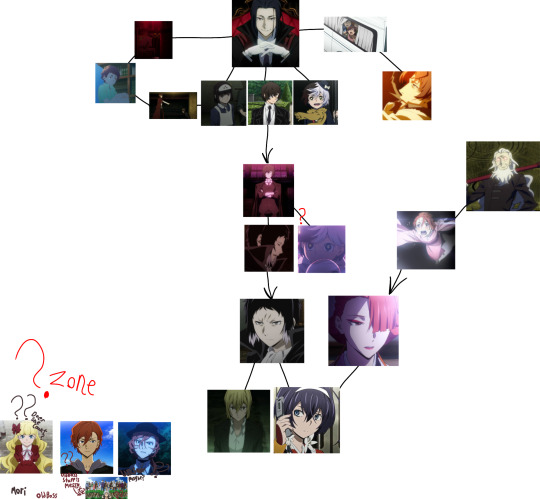
I don't know what I'm doing anymore but here is my personal take on the mori affect/abuse web/abuse cycle
#bsd#bungou stray dogs#bungo stray dogs#dazai osamu#akutagawa ryuunosuke#mori ougai#yosano akiko#tachihara michizou#tachihara shunzen#oda sakunosuke#ozaki kouyou#higuchi ichiyo#izumi kyouka#yumeno kyuusaku#bsd abuse web#mori affect#bsd elise#former pm boss#nakahara chuuya#the sheep#bsd sheep#oda's kids#mori ogai#bsd dazai#dazai#osamu dazai#akutagawa ryunosuke#ryuunosuke akutagawa#kyuusaku yumeno#kyōka izumi
140 notes
·
View notes
Text
I think one of the things I'm most mad about in the bsd fandom is the way we treat the abuse cycle.
For one, it isn't a cycle. It's a web. It doesn't just include mori, dazai, akutagawa and kyouka, but also yosano, q, higuchi and kouyo, whether as victims or abusers.
Also, I get so mad about the way we treat dazai. Dazai as treated as if he's just an abuser, whereas akutagawa is treated as if he's just a victim. And they are both abuser and victim, so it makes me mad that only one is held accountable for their actions. (Though obviously dazai is my favourite so I am biased).
What also makes me mad about this is the fact that realistically, dazai has more of an excuse.
Akutagawa was 14 when he entered the mafia, and dazai is 2 years older than him, making him only 16. This makes him not only a child, legally, but also still under Mori's, I.e. his abusers, thumb, while abusing akutagawa.
Akutagawa while abusing kyouka, however, is 20, and has been away from his abuser for four years? At that point? And obviously he hasn't healed, because he's an abuse victim, and that doesnt go away very easily. But he isnt being abused while he is abusing kyouka, and has been in a more healthy environment.
Obviously, at the end of the day, dazai and akutagawa are just victims of the cycle, and neither are more to blame than the other.
But if that's what you want to acknowledge, treat them equally, not just the way you want.
#bungou stray dogs#bsd dazai#bsd akutagawa#moris trauma children#bsd abuse cycle/web#im so mad for dazai tbh#stop treating my baby so badly#he was a literal child#and he deserves to be happy
14 notes
·
View notes
Text


“Akutagawa - he’s like a sword without a sheath.” Dazai grinned from ear to ear. “He’ll surely become the Mafia’s strongest skill user in the not-so-distant future, but for now he needs someone who can teach him how to put that sword away.”
- Dazai Osamu, Dark Era Light Novel

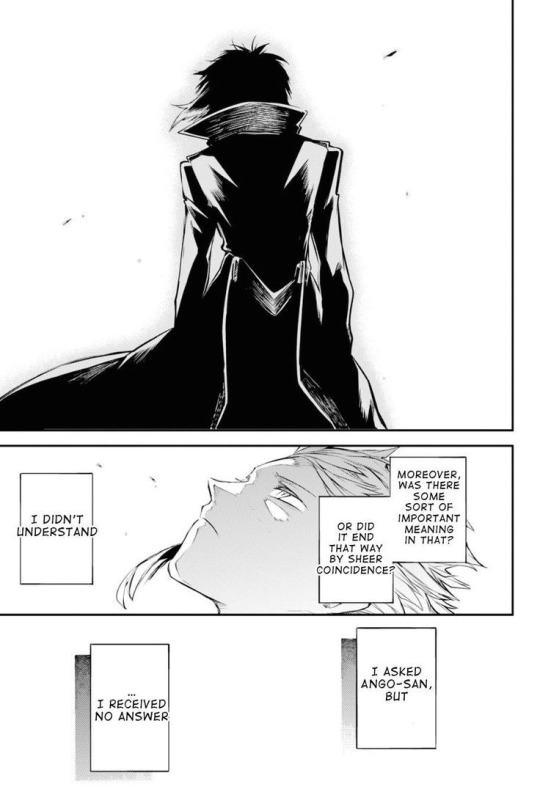
“When I first saw him over in the slums, I was horrified. His talents are extraordinary, and his skill is extremely destructive. Plus, he’s stubborn. If I’d have left him to his own devices, he would have ended up a slave to his own powers until he destroyed himself.”
- Dazai Osamu, Dark Era Light Novel
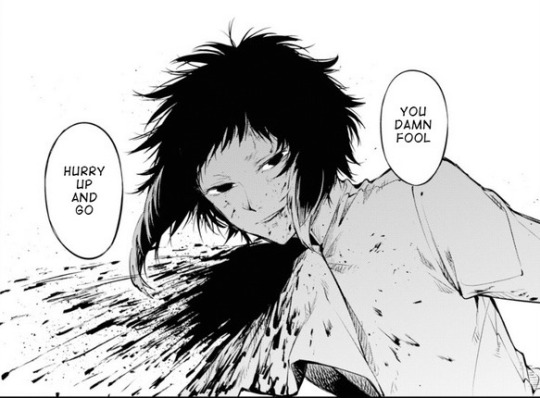

“Akutagawa-kun has always been this way. He runs off by himself, he causes destruction and, in the end, he contributes the most.”
- Mori Ougai, Season 2 Ep 24
#just been … thinking#used abused and doomed by the narrative#ripping my hair out#Akutagawa#akutagawa ryuunosuke#bungou stray dogs#web weaving#web weave#akutagawa web weave#bsd web weave#bsd#spilled soup
42 notes
·
View notes
Text
just to distinguish between the abuse cycle and the main chain in it without causing HAVOC, im just gonna call them the Dog Haters, because at least 3/4 of them hate dogs
#if i catch one more person calling only those four the abuse cycle...#or worse: “its not the abuse CYCLE its tbe abuse WEB”#SHUT UP#the abuse cycle is a pattern of behaviour not a group of people. the term in a bsd context (amd im general) considers#that those who are abused tend to abuse others. such as with the dog haters kouyo the headmaster and other like them#YOU EXCLUDE THE HEADMASTER AND ATSUSHI WHEN YOU SAY ABUSE WEB.#anyways these fuckers are the dogs haters now because im sick of the SAME ARGUMENTS#bsd#bungo stray dogs#bungou stray dogs#bsd dog haters#bsd abuse chain#abuse cycle bsd#bsd abuse cycle#bsd kyouka#bsd dazai#bsd akutagawa#<- i know they canonically hate dogs. idk if mori does but now he does#bsd mori
23 notes
·
View notes
Text
it's dazai & akutagawa.

it's dazai & akutagawa. it's dazai & akutagawa. it's dazai & akutagawa. it's dazai & akutagawa. it's dazai & akutagawa. it's dazai & akutagawa. it's dazai & akutagawa. it's dazai & akutagawa. it's dazai & akutagawa. it's dazai & akutagawa. it's dazai & akutagawa. it's dazai & akutagawa. it's dazai & akutagawa. it's dazai & akutagawa. it's dazai & akutagawa. it's dazai & akutagawa. it's dazai & akutagawa. it's dazai & akutagawa.
ive seen so many people try to excuse what akutagawa did BECAUSE of dazai's actions, but if you're gonna do that then shouldn't they also excuse what dazai did BECAUSE of mori's actions?
BOTH dazai & akutagawa have done wrong.
it's crazy how many people want to try & blame ONLY dazai for the shitty things he himself has done & the shitty things akutagawa has done?
im not saying dazai is innocent btw, like. ultimately, mori is to blame for STARTING the abuse web. BUT he is not the only person who actively contributed to it. dazai knew well enough that what he was doing was wrong, same goes to akutagawa. they are ALL to blame for their OWN things.
n e wayz, thx 4 coming to my lil rant :3
ps, i love both dazai & akutagawa lmao. that always seems to surprise people for some reason
#bsd#bungou stray dogs#dazai osamu#akutagawa ryunosuke#ougai mori#osamu dazai#ryunosuke akutagawa#mori ougai#abuse web#abuse cycle
15 notes
·
View notes
Note
Yandere port mafia dazai hcs
______๑♡๑______ ______๑♡๑______
Trigger Warnings
1. Obsessive Behavior- Depictions of unhealthy obsession, fixation, and possessiveness.
2. Manipulation and Gaslighting-Psychological manipulation and subtle forms of emotional abuse, including isolating the subject from their friends and support system.
3. Stalking-Mention of stalking, surveillance, and monitoring someone’s movements without their consent.
4. Threats and Violence-Implications and descriptions of harm toward others (e.g., romantic rivals, friends). References to threats, intimidation, and potential physical violence.
5. Loss of Agency- Themes of control and lack of personal freedom, such as orchestrating life events to trap the subject.
6. Kidnapping and Confinement (Implied) Mentions or implications of taking extreme measures to prevent someone from leaving.
7. Unhealthy Relationships-Exploration of toxic, unbalanced relationships framed as devotion or love.
8. Emotional Distress- Themes of fear, unease, and emotional turmoil experienced by the subject.
9. Sadism- Mentions of deriving enjoyment from the discomfort or fear of others.
10. Self-Loathing and Morbid Ideation/Subtle references to Dazai’s own self-destructive tendencies and how they fuel his obsession.
______๑♡๑______ ______๑♡๑______
These headcanons depict dark and mature themes, so it’s important to approach with caution, especially if these topics are personally triggering or upsetting.
Yandere Port Mafia Dazai: Headcanons
(Haven’t wrote BSD in a long time lol)

1. The Nature of His Obsession
Dazai’s obsession would begin subtly, almost imperceptibly. At first, he’d convince himself that he’s merely intrigued by you—a passing interest, a distraction from the constant void of his own self-loathing. But as time goes on, that intrigue would evolve into a fixation. He’d become enamored with the way you carry yourself, the way your voice sounds when you speak to him, and the warmth you unknowingly bring into his otherwise bleak existence.
He would rationalize his growing obsession as love, but it wouldn’t be love in a conventional sense. Dazai doesn’t believe in pure, untainted emotions. For him, love is possession, control, and the eradication of anything that could separate you from him.
2. His Methods of Control
Dazai would approach his obsession with the same cold, calculated precision he applies to his work in the Port Mafia. He’d gather information about you, whether by stalking you himself or using the Mafia’s vast network of spies and informants. Your routines, relationships, and even your secrets would become his to know.
He wouldn’t confront you directly at first. Instead, he’d manipulate events from behind the scenes. If someone posed a threat—be it a romantic rival, a nosy friend, or even a coworker who took up too much of your time—they’d suddenly find themselves facing inexplicable misfortune. Dazai would relish in his ability to control the narrative of your life without you even realizing it.
3. The Mask He Wears
One of Dazai’s greatest strengths is his ability to wear masks. To you, he’d present himself as charming, playful, and harmless. He’d use his wit and humor to put you at ease, to make you see him as a friend—someone you could trust. But beneath that charming exterior lies a predator, watching and waiting for the perfect moment to pull you deeper into his web.
He’d go out of his way to make you feel special, showering you with attention, compliments, and small acts of kindness. At the same time, he’d subtly plant seeds of doubt about others in your life. “Oh, that friend of yours… they don’t seem to appreciate you the way they should,” he’d say with a concerned smile. His words would linger in your mind, slowly isolating you without you even realizing it.
4. The Dark Side of His Devotion
Dazai’s darker tendencies would surface whenever he felt his control slipping. If you expressed interest in someone else or tried to distance yourself from him, his playful demeanor would vanish, replaced by a chilling intensity. He’d corner you with a disarming smile, his voice low and calm.
“Why would you need anyone else when you have me?” he’d ask, his dark eyes locking onto yours. “I’ve done so much for you. I’ve protected you. Can’t you see that we’re meant to be together?”
If his words didn’t sway you, he’d escalate. A romantic rival might disappear under mysterious circumstances. A friend who encouraged you to stay away from him might receive a chilling warning—or worse. Dazai wouldn’t hesitate to destroy anyone who threatened his hold on you.
5. The Depth of His Affection
For all his manipulative and violent tendencies, Dazai would genuinely believe that he’s acting out of love. In his mind, he’s saving you—not just from external threats, but from the loneliness and despair that he sees as an inevitable part of life. He’d tell himself that you need him just as much as he needs you, even if you don’t realize it yet.
And in his own twisted way, Dazai would be tender. He’d remember the little things that make you happy—a favorite drink, a beloved book—and use them to win your favor. He’d be attentive to your needs, always knowing when you’re upset and doing whatever it takes to comfort you. But his kindness would always come with strings attached, binding you tighter to him with each passing day.
______๑♡๑______ ______๑♡๑______
You first met Dazai at a café you frequented near the Port Mafia’s headquarters. He was a regular customer, always sitting in the same corner booth with a book in hand and a mischievous smile on his face. At first, he seemed harmless—just another charming stranger with a knack for making conversation. But there was something about the way he watched you that made your skin prickle, as though he could see straight through you.
“Funny, isn’t it?” he said one day, catching you off guard as you passed by his table. “How people can spend their entire lives searching for something, only to find it when they least expect it.”
You blinked at him, unsure how to respond. “I… suppose so. What are you searching for?”
He grinned, his eyes gleaming with something you couldn’t quite place. “Oh, I think I’ve already found it.”
The weeks that followed were a blur of encounters. Dazai seemed to appear everywhere you went, always with a clever remark or a kind gesture that left you questioning whether you were imagining things. He was attentive, almost too much so, remembering details you didn’t recall telling him. Yet, despite the unease that lingered in the back of your mind, you found yourself drawn to him.
It wasn’t until your coworker, a close friend, stopped speaking to you that you began to notice the cracks in Dazai’s mask. “They said it was better this way,” Dazai explained when you confronted him. His tone was light, but there was an edge to it that made your stomach twist. “I might have… encouraged them to think about how they were treating you. After all, I can’t stand seeing you hurt.”
You tried to pull away after that, to put some distance between you and the man who had somehow inserted himself into every corner of your life. But no matter where you went, Dazai was always there—watching, waiting. And when you finally gathered the courage to confront him, he didn’t deny it.
“Of course I’ve been watching you,” he said, his voice soft but unyielding. “How else could I keep you safe? You’re too precious to leave unprotected. Don’t you see? Everything I’ve done has been for you.”
His words sent a chill down your spine, but the look in his eyes—equal parts devotion and madness—left you speechless. For the first time, you realized just how tightly he had woven himself into your life, leaving no room for escape.
#gothicxreylover#gender neutral reader#bungou stray dogs#yandere bungou stray dogs#yandere x reader#bsd dazai#dazai osamu#bungo stray dogs#yandere dazai osamu#yandere headcanons#yandere imagines#tw yandere#dazai x you#dazai headcanons#bsd dazai osamu#dazai x reader#yandere dazai
127 notes
·
View notes
Text
Ok the bsd community on Tiktok is really starting to piss me off. Some of y'all have such piss poor media comprehension I can feel my own brain cells suffering. Tell me why I saw someone say the abuse cycle DOESN'T EXIST!??!? Bsd is such a complex story and some of these takes hurt my soul!
Dazai is my absolute favourite character of all time so I may be a little biased here, but I've seen people genuinely say "Dazai is not a victim" or "People want him to a be a victim so bad". Like regardless of how you personally interpret Mori's treatment of him it is VERY CLEAR he was at LEAST mentally abused.
Especially when it comes to discussions around SA. I think both interpretations are completely valid and okay and you can choose not interact with content you disagree with! There is no concrete confirmation of either interpretation in canon. If you are uncomfortable with the theory/Au. Don't like don't read. But even Mori aside Dazai is still heavily implied to be a victim of sexual assault in the nurse scene during the cannibalism arc, and it is shown repeatedly through other mafia members how they are trained to "use their body" on missions. E.g Kyouka.
People also treat his role in the abuse cycle/web as worse than Akutagawa's? I'd like to point out here that Dazai was still a minor when he took Akutagawa in AND was actively being abused at the time. People treat him like he's more responsible or worse for his abuse of Akutagawa than Akutagawa is of Kyouka. I've seen people argue that because of how smart he is he is more responsible for his actions at 16 than Akutagawa is AT TWENTY.
Tiktok isn't the only platform I've seen this on but its the most abundant there. If you can't put the effort in to look at the story past face value than I personally don't think bsd is for you. There are genuine reasons to dislike Dazai or the Mori SA theory/Au but I never see them! I'm just tired of seeing so much mischaracterisation in this fandom, especially because of how close the story and Dazai are to my heart.
32 notes
·
View notes
Text
If Dazai is a bad person, then Ryunosuke is just as bad. I feel like this fandom babies Ryunosuke so much, but the completely ignores the fact that Dazai and Kyouka, too were also. Yes, what Dazai did to Ryunosuke was fucked up and he still manipulates him. That's disgusting. But Ryunosuke is just as bad, having abused both Kyouka and Higuchi. And l dont wanna see you Ryunosuke stans going "but - but he said he was happy for Kyouka 🥺"
THAT DOESN'T MEAN HES SORRY, AND HE STILL, ABUSES HIGUCH! Yes. Dazai hasn't apologized to either Ryunosuke and Yumeno, but: Ryunosuke has done just as bad. If we're going to see things in black and white, then both are horrible people and neither of them deserve to live. You see how wrong that sounds? Let me just get more into the abuse web for a minute.
Mori abused Yosano and Yumeno both physically and psychologically, meanwhile his abuse to Dazai was mainly physchological. Mori abusing Dazai was the result of his fear of Dazai (as stated in some novels). Yosano and Yumeno ended their branch of the abuse web, but Dazai went on to abuse both Yumeno (this isnt even slightly confirmed, it might just be abandonment, because there are multiple results on how he acted with Yumeno. Some say they were friends, but Dazai abandoned them after an incident, and the others say he neglected Yumeno. Some say he treated him the same way as Ryunosuke, but I'm not sure bout this yet.) and Ryunosuke. Ryunosuke abused Kyouka and Higuchi And not to mention, Kyouka was also abused by Kouyou. Now, in my opinion, none of the people in this abuse web (except for Mori) are bad people. Of course, Yosano, Yumeno, Kyouka, and Higuchi ended their branch of the web, so I don't need to explain that. But the others actions were fucked up as hell but understandable. Dazai was a kid in a bad mental state, with suicidal tendencies and being exposed to the Mafia at the age of fourteen. And, not to mention, had to be the witness for a murder. He became an executive at 16, and was regularly exploited and dehumanised- not to mention psychologically abused by Mori. l don t think anybody can expect a person in that situation - ESPECIALLY A CHILD (and I don't wanna hear anybody saying "he was fourteen, that's old enough." HE WASN'T EVEN AN ADULT YET, AND NOT TO MENTION, THE HUMAN BRAIN DOESN'T FULLY DEVELOP UNIL A WHILE AFTER ADULTHOOD! Hes a child in every way at that part of his life) to have a good patience, and good training methods, to mention.
And, we only saw Dazai physically attack Ryunosuke once and that was as a punishment. And before you say it was still abuse- I KNOW
But I feel like we ignore the fact that other than those punishments, there was no mention of Dazai injuring Ryunosuke. And after Odasaku's death, which was a big wake up call for Dazai, he left the Port Mafia and hes great with children, and is attempting (AND SUCCEEDING!) in somewhat redeeming himself. And no, Ryunosuke isnt a bad person either. He was also a kid when Dazai abused him, and grew up with 'survival for the fittest', not to mention the fact he already knew it was unlikely for him to live much after adulthood (lung disease) probably made him desperate to accomplish something before he died.
He was also worried for his sister, Gin, and in just as bad a mentality as Dazai was. His actions to Kyouka and Higuchi were the same motives as Dazai's to him, him simply not knowing better. Again, I DO NOT CONDONE ANY OF THIS! I agree with the rest of the fandom when they say that: Dazai and Ryunosuke are abusers and need to face their actions. And for Kouyou, she has a similar ability to Kyouka, and she's also similar to her. She saw herself in Kyouka, and didni't want her to suffer like she did, so she started self-projecting, not realizing that she was hurting Kyouka instead of protecting her.
It's very obvious that she's sorry for her actions, and when Kyouka left the Port Mafia, her healing began.
I find it honestly sad that our fandom just views BSD in black and white, when it's just all shades of gray No black or what AT ALL. Kenji isnt completely innocent, and Fyodor and Mori arent completely evil. Before somebody says "yOu'Re oVeRrEaCtInG", Bungo Stray Dogs, in psychological and some physical aspects, is a lot like real life. In real life, nobody is truly evil, and nobody is truly innocent. If you simplify everything even in a show, I feel sorry for the people who have to live with being seents thet view of life. For example, a person would get mad at somebody for stealing, but what if that person had a child to support but no money? The action was shitty, but the motives were understandable. I think it's an important detail on how realistically Asagiri and Harukawa represent realife aspects to BSD, and especially in the abuse web.
#bungo stray dogs#osamu dazai#ryunosuke akutagawa#kouyou ozaki#kyouka izumi#kyusaku yumeno#akiko yosano#mori ogai#bsd rant#tw abuse
8 notes
·
View notes
Note
Hi Kavi! :)
2, 7, 16, 24
hello rai <3
infinitely amused at getting enlisted into the choose violence ask game (-> i have already spent too much time being a hater recently so i'm not rb-ing it but like if anyone else wants to enlist me. well. 😶) so i'm answering this while dodging several other asks i am supposed to be answering rn.
2. a compelling argument for why your fave would never top or bottom
okay firstly i don't have that many strict top/bottom opinions usually. i am often a switch truther or a they-would-simply-not-fuck-that-way truther— i tend to care more abt power dynamics in individual rships in a d/s sense. anyway that being said akutagawa would not top because he simply does not use his dick that way <3 have you seen him <3
^ fine. okay. he could try to top. he would not do well at it though.
7. what character did you begin to hate not because of canon but because how how the fandom acts about them?
chuuya </3 i'm so fond of him (-> 15 and stormbringer as lightnovels are so much) but simultaneously the fandom is eternally insufferable about him. fanfavorite crimes forever— skk often get the majority of fan-focus, which is fair in the case of dazai to me (he is very, very central to the manga) but tends to be perplexing for me in the case of chuuya, who is a much more minor character and who often gets like... a personality transplant in fandom regardless.
atm i literally do not venture out into the tags though so i'm safe o7
16. you can't understand why so many people like this thing (characterization, trope, headcanon, etc)
am i allowed to say closed-rship archetypical romance in bsd— [gunshot]
^ dodges the bullet. i am relationship anarchy polyamorous aromantic web truthing for the bsd characters forever; closed and clear-cut romance between any of the characters often makes me go ? because it's not how i see them...
there are interesting takes i've seen done and respect and often cheer on from the sidelines, but specifically like. cliche shipfic for characters makes me stare and go why. especially in cases where i think they would be sharper and more interesting with each other than that.
24. topic that brings up the most rancid discourse
i avoid so much rancid discourse by living in an echochamber. in general though, i think familial connections in fandom bring up the worst discourse— parents particularly, which i think in bsd gets supplanted by mentor-mentee discourse due to the lack of available parents (asagiri loves an orphan).
there's a lot of projection that goes into it from fandom and a lack of nuance (a particular premade shape of... this is how you're supposed to handle abuse; this is what abuse looks like; etc), and i think people warp and disregard the text in favor of what they think should be the narrative being delivered, which makes me go :(
5 notes
·
View notes
Text
I've been thinking about the similarities between these two recently
the color schemes these two scenes have is so similar and no one talks about it
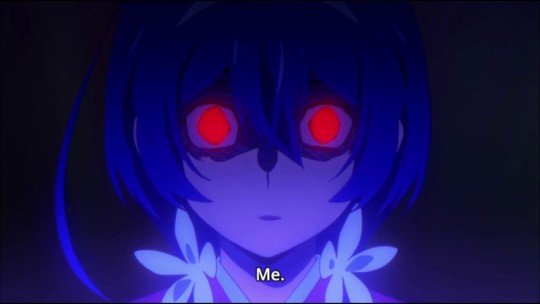

And something I find very interesting is that Atsushi states he's giving Kyouka a reason to be worthy of living, which is what Akutagawa was trying to give her and what he asked Dazai to give him


Also while not directly Kyouka & Akutagawa related I feel the need to note that Akutagawa imitates Dazai's treatment of him

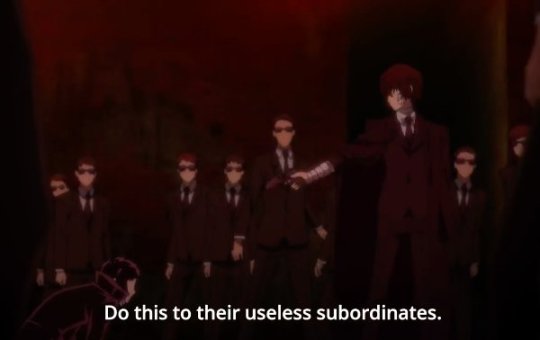
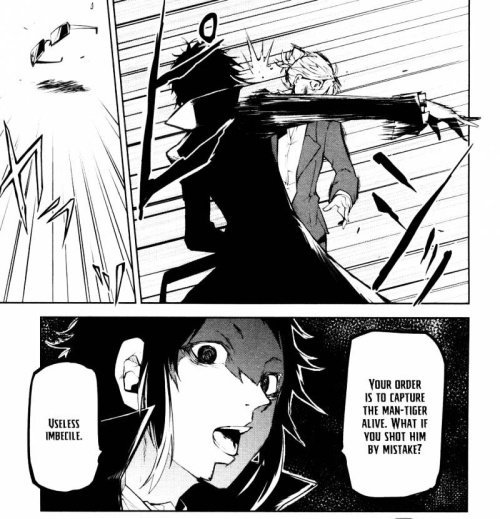
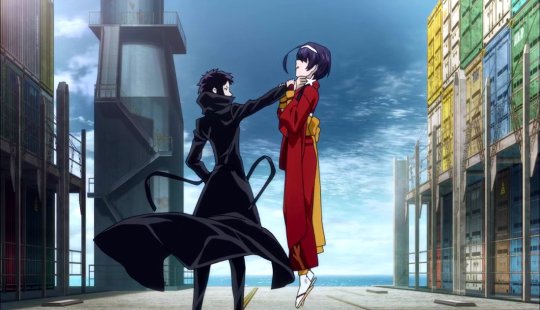
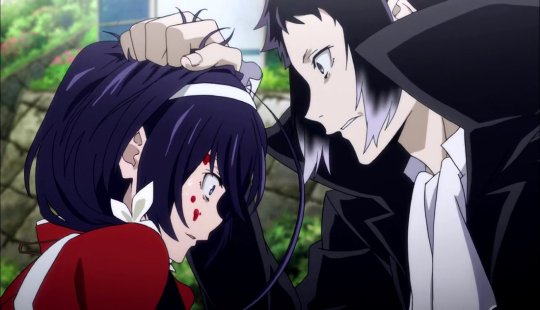
So yeah Akutagawa & Kyouka's similarities make me sad

Well that's all for this ig
#bsd analysis#bsd rant#bsd#bungo stray dogs#bungou stray dogs#ryuunosuke akutagawa#bsd akutagawa#akutagawa ryuunosuke#akutagawa ryūnosuke#akutagawa ryunosuke#ryunosuke akutagawa#bsd ryunosuke#ryūnosuke akutagawa#kyouka#izumi kyouka#bsd kyouka#kyouka izumi#kyōka izumi#izumi kyōka#ichiyo higuchi#higuchi ichiyo#bsd higuchi#higuchi ichiyou#ichiyou higuchi#ichiyō higuchi#higuchi ichiyō#bsd abuse web#bsd abuse cycle#dazai#bsd dazai
133 notes
·
View notes
Text
When I rant I RANT. like i live my silly little 15 minute long voice messages that are in a series :3
Like the other day I was talking about my Christmas jumper, th en a gacha react I watched, then the abuse cycle in bsd, the abuse Web, kyuus backstory, mori, angst opportunities for chuuya, then that i almost got hit by a truck
0 notes
Note
Okay? I never said that Kyouka or Higuchi deserved being treated like that unlike you do by saying that Akutagawa "deserves" being beaten as a teenager, it's like you don't understand the abuse web in bsd is a legit thing it's not that hard to understand last I checked Dazai kicked & punched Akutagawa when Akutagawa was 16 and called him useless before shooting at him but I guess that's okay because you dislike Akutagawa (fun fact that's still abuse)
Stop shipping quality man Dazai Osamu with irrelevant flop side characters who absolutely do not deserve his greatness and beauty
are you implying that dazai is a quality man? 😂🤣
442 notes
·
View notes
Text
Andrew shiira arrest

#ANDREW SHIIRA ARREST CODE#
#ANDREW SHIIRA ARREST FREE#
In its complaint against Ross William Ulbricht of Silk Road, the US Federal Bureau of Investigation acknowledged that Tor has "known legitimate uses". It has also been used to brick IoT devices. Tor can be used for anonymous defamation, unauthorized news leaks of sensitive information, copyright infringement, distribution of illegal sexual content, selling controlled substances, weapons, and stolen credit card numbers, money laundering, bank fraud, credit card fraud, identity theft and the exchange of counterfeit currency the black market utilizes the Tor infrastructure, at least in part, in conjunction with Bitcoin. At the same time, GCHQ has been using a tool named "Shadowcat" for "end-to-end encrypted access to VPS over SSH using the Tor network". It has been targeted by the American National Security Agency and the British GCHQ signals intelligence agencies, albeit with marginal success, and more successfully by the British National Crime Agency in its Operation Notarise. Tor has been described by The Economist, in relation to Bitcoin and Silk Road, as being "a dark corner of the web". These can include privacy protection or censorship circumvention, as well as distribution of child abuse content, drug sales, or malware distribution. Tor is not designed to completely erase tracking but instead to reduce the likelihood for sites to trace actions and data back to the user. Tor is not meant to completely solve the issue of anonymity on the web.
#ANDREW SHIIRA ARREST FREE#
State Department, the National Science Foundation, and – through the Broadcasting Board of Governors, which itself partially funded Tor until October 2012 – Radio Free Asia) and seek to subvert it. Tor has, for example, been used by criminal enterprises, hacktivism groups, and law enforcement agencies at cross purposes, sometimes simultaneously likewise, agencies within the U.S. Tor enables its users to surf the Internet, chat and send instant messages anonymously, and is used by a wide variety of people for both licit and illicit purposes. Bureau of Democracy, Human Rights, and Labor and International Broadcasting Bureau, Internews, Human Rights Watch, the University of Cambridge, Google, and Netherlands-based Stichting NLnet. The EFF acted as The Tor Project's fiscal sponsor in its early years, and early financial supporters included the U.S. In 2006, Dingledine, Mathewson, and five others founded The Tor Project, a Massachusetts-based 501(c)(3) research-education nonprofit organization responsible for maintaining Tor.
#ANDREW SHIIRA ARREST CODE#
In 2004, the Naval Research Laboratory released the code for Tor under a free license, and the Electronic Frontier Foundation (EFF) began funding Dingledine and Mathewson to continue its development. The first public release occurred a year later. The alpha version of Tor, developed by Syverson and computer scientists Roger Dingledine and Nick Mathewson and then called The Onion Routing project (which was later given the acronym "Tor"), was launched on 20 September 2002. Onion routing is implemented by means of encryption in the application layer of the communication protocol stack, nested like the layers of an onion. Reed and David Goldschlag, to protect American intelligence communications online. The core principle of Tor, onion routing, was developed in the mid-1990s by United States Naval Research Laboratory employees, mathematician Paul Syverson, and computer scientists Michael G.
4.9 Relay early traffic confirmation attack.
4.6 Some protocols exposing IP addresses.
4.2.1 Autonomous system (AS) eavesdropping.
Comparison of Internet Relay Chat clients.
Overlay network, mix network, onion router, Anonymity application To view the current address, phone number, age, and associates of any adult in Honolulu, HI simply click a name listed below.Unix-like, ( Android, Linux, BSD, macOS), Microsoft Windows, IOS. Select a Person in Honolulu, HI to View Detailsīrowse the list of people in Honolulu, HI below.

0 notes
Note
ooc// like i just wanna point at A: dazai ‘suicidal maniac’ osamu, B: the abuse web C: the great war D: Nakajima ‘the icon of childhood trauma’ atsushi
like bsd CANONICALLY. is triggering, do you see asagiri-sensei telling everyone that his (absolutely amazing) works are triggering??? no- everything is read at your own risk
loc) I think I’m gonna delete the Ango blog. Sorry.
-Ango mod
ooc// hey, do what you need to do okay? as much as i’d be sad to see it go your happiness is more important
@discourse-on-decadence
14 notes
·
View notes
Link
Salil Deshpande Contributor
Salil Deshpande serves as the managing director of Bain Capital Ventures. He focuses on infrastructure software and open source.
More posts by this contributor
After the Satoshi Roundtable, is there a way to bridge the bitcoin divide?
The Holy Grail of Web Scale
There’s a dark cloud on the horizon. The behavior of cloud infrastructure providers, such as Amazon, threatens the viability of open source.
During 13 years as a venture investor, I have invested in the companies behind many open-source projects:
Spring
Mule
Ruby Rails
Groovy
Grails
Maven
Gradle
Redis
SysDig
Hazelcast
Akka
Scala
Cassandra
Spinnaker
and others.
Open source has served society, and open-source business models have been successful and lucrative. Life was good.
Amazon’s behavior
I admire Amazon’s execution. In the venture business we are used to the large software incumbents (such as IBM, Oracle, HP, Compuware, CA, EMC, VMware, Citrix and others) being primarily big sales and distribution channels, which need to acquire innovation (i.e. startups) to feed their channel. Not Amazon. In July 2015, The Wall Street Journal quoted me as saying, “Amazon executes too well, almost like a startup. This is scary for everyone in the ecosystem.” That month, I wrote Fear The Amazon Juggernaut on investor site Seeking Alpha. AMZN is up 400 percent since I wrote that article. (I own AMZN indirectly.)
But to anyone other than its customers, Amazon is not a warm and fuzzy company. Numerous articles have detailed its bruising and cutthroat culture. Why would its use of open source be any different?
Go to Amazon Web Services (AWS) and hover over the Products menu at the top. You will see numerous open-source projects that Amazon did not create, but runs as-a-service. These provide Amazon with billions of dollars of revenue per year.
For example, Amazon takes Redis (the most loved database in StackOverflow’s developer survey), gives very little back, and runs it as a service, re-branded as AWS Elasticache. Many other popular open-source projects including, Elasticsearch, Kafka, Postgres, MySQL, Docker, Hadoop, Spark and more, have similarly been taken and offered as AWS products.
To be clear, this is not illegal. But we think it is wrong, and not conducive to sustainable open-source communities.
Commons Clause
In early 2018, I gathered together creators, CEOs or chief counsels of two dozen at-scale open-source companies, some of them public, to talk about what to do. In March I spoke to GeekWire about this effort. After a lot of constructive discussion the group decided that rather than beat around the bush with mixing and matching open-source licenses to discourage such behavior, we should create a straightforward clause that prohibits the behavior. We engaged respected open-source lawyer Heather Meeker to draft this clause.
In August 2018 Redis Labs announced their decision to add this rider (i.e. one additional paragraph) known as the Commons Clause to their liberal open-source license for certain add-on modules. Redis itself would remain on the permissive BSD license — nothing had changed with Redis itself! But the Redis Labs add-on modules will include the Commons Clause rider, which makes the source code available, without the ability to “sell” the modules, where “sell” includes offering them as a commercial service. The goal is to explicitly prevent the bad behavior of cloud infrastructure providers.
Anybody else, including enterprises like General Motors or General Electric, can still do all the things they used to be able to do with the software, even with Commons Clause applied to it. They can view and modify the source code and submit pull-requests to get their modifications into the product. They can even offer the software as-a-service internally for employees. What Commons Clause prevents is the running of a commercial service with somebody else’s open-source software in the manner that cloud infrastructure providers do.
This announcement has — unsurprisingly, knowing the open-source community — prompted spirited responses, both favorable and critical. At the risk of oversimplifying: those in favor view this as a logical and positive evolution in open-source licensing that allows open-source companies to run viable businesses while investing in open-source projects. Michael DeHaan, creator of Ansible, in Why Open Source Needs New Licenses, put one part particularly well:
We see people running open source “foundations” and web sites that are essentially talking heads, spewing political arguments about the definition of “open source” as described by something called “The Open Source Initiative”, which contains various names which have attained some level of popularity or following. They attempt to state that such a license where the source code is freely available, but use cases are limited, are “not open source”. Unfortunately, that ship has sailed.
Those neutral or against point out that the Commons Clause makes software not open source, which is accurate, and that making parts of the code base proprietary is against the ethos of open source; and Redis Labs must be desperate and having trouble making money.
First, do not worry about Redis Labs. The company is doing very, very well. And Redis is stronger, more loved and more BSD than ever before.
More importantly, we think it is time to reexamine the ethos of open source in today’s environment. When open source became popular, it was designed for practitioners to experiment with and build on, while contributing back to the community. No company was providing infrastructure as a service. No company was taking an open-source project, re-branding it, running it as a service, keeping the profits and giving very little back.
Our view is that open-source software was never intended for cloud infrastructure companies to take and sell. That is not the original ethos of open source. Commons Clause is reviving the original ethos of open source. Academics, hobbyists or developers wishing to use a popular open-source project to power a component of their application can still do so. But if you want to take substantially the same software that someone else has built, and offer it as a service, for your own profit, that’s not in the spirit of the open-source community.
As it turns out in the case of the Commons Clause, that can make the source code not technically open source. But that is something we must live with, to preserve the original ethos.
Apache + Commons Clause
Redis Labs released certain add-on modules as Apache + Commons Clause. Redis Labs made amply clear that the application of Commons Clause made them not open source, and that Redis itself remains open source and BSD-licensed.
Some rabid open-source wonks accused Redis Labs of trying to trick the community into thinking that modules were open source, because they used the word “Apache.” (They were reported to be foaming at the mouth while making these accusations, but in fairness it could have been just drool.)
There’s no trick. The Commons Clause is a rider that is to be attached to any permissive open-source license. Because various open-source projects use various open-source licenses, when releasing software using Commons Clause, one must specify to which underlying permissive open-source license one is attaching Commons Clause.
Why not AGPL?
There are two key reasons to not use AGPL in this scenario, an open-source license that says that you must release to the public any modifications you make when you run AGPL-licensed code as a service.
First, AGPL makes it inconvenient but does not prevent cloud infrastructure providers from engaging in the abusive behavior described above. It simply says that they must release any modifications they make while engaging in such behavior. Second, AGPL contains language about software patents that is unnecessary and disliked by a number of enterprises.
Many of our portfolio companies with AGPL projects have received requests from large enterprises to move to a more permissive license, since the use of AGPL is against their company’s policy.
Balance
Cloud infrastructure providers are not bad guys or acting with bad intentions. Open source has always been a balancing act. Many of us believe in our customers and peers seeing our source code, making improvements and sharing back. It’s always a leap of faith to distribute one’s work product for free and to trust that you’ll be able to put food on the table. Sometimes, with some projects, a natural balance occurs without much deliberate effort. But at other times, the natural balance does not occur: We are seeing this more and more with infrastructure open source, especially as cloud infrastructure providers seek to differentiate by moving up the stack from commodity compute and storage to higher level infrastructure services.
Revisions
The Commons Clause as of this writing is at version 1.0. There will be revisions and tweaks in the future to ensure that Commons Clause implements its goals. We’d love your input.
Differences of opinion on Commons Clause that we have seen expressed so far are essentially differences of philosophy. Much criticism has come from open-source wonks who are not in the business of making money with software. They have a different philosophy, but that is not surprising, because their job is to be political activists, not build value in companies.
Some have misconstrued that it prevents people from offering maintenance, support or professional services. This is a misreading of the language. Some have claimed that it conflicts with AGPL. Commons Clause is intended to be used with open-source licenses that are more permissive than AGPL, so that AGPL does not have to be used! Still, even with AGPL, few users of an author’s work would deem it prudent to simply disregard an author’s statement of intent to apply Commons Clause.
Protecting open source
Some open-source stakeholders are confused. Whose side should they be on? Commons Clause is new, and we expected debate. The people behind this initiative are committed open-source advocates, and our intent is to protect open source from an existential threat. We hope others will rally to the cause, so that open-source companies can make money, open source can be viable and open-source developers can get paid for their contributions.
via TechCrunch
0 notes
Text
Commons Clause stops open-source abuse
Salil Deshpande Contributor
Salil Deshpande serves as the managing director of Bain Capital Ventures. He focuses on infrastructure software and open source.
More posts by this contributor
After the Satoshi Roundtable, is there a way to bridge the bitcoin divide?
The Holy Grail of Web Scale
There’s a dark cloud on the horizon. The behavior of cloud infrastructure providers, such as Amazon, threatens the viability of open source.
During 13 years as a venture investor, I have invested in the companies behind many open-source projects:
Spring
Mule
Ruby Rails
Groovy
Grails
Maven
Gradle
Redis
SysDig
Hazelcast
Akka
Scala
Cassandra
Spinnaker
and others.
Open source has served society, and open-source business models have been successful and lucrative. Life was good.
Amazon’s behavior
I admire Amazon’s execution. In the venture business we are used to the large software incumbents (such as IBM, Oracle, HP, Compuware, CA, EMC, VMware, Citrix and others) being primarily big sales and distribution channels, which need to acquire innovation (i.e. startups) to feed their channel. Not Amazon. In July 2015, The Wall Street Journal quoted me as saying, “Amazon executes too well, almost like a startup. This is scary for everyone in the ecosystem.” That month, I wrote Fear The Amazon Juggernaut on investor site Seeking Alpha. AMZN is up 400 percent since I wrote that article. (I own AMZN indirectly.)
But to anyone other than its customers, Amazon is not a warm and fuzzy company. Numerous articles have detailed its bruising and cutthroat culture. Why would its use of open source be any different?
Go to Amazon Web Services (AWS) and hover over the Products menu at the top. You will see numerous open-source projects that Amazon did not create, but runs as-a-service. These provide Amazon with billions of dollars of revenue per year.
For example, Amazon takes Redis (the most loved database in StackOverflow’s developer survey), gives very little back, and runs it as a service, re-branded as AWS Elasticache. Many other popular open-source projects including, Elasticsearch, Kafka, Postgres, MySQL, Docker, Hadoop, Spark and more, have similarly been taken and offered as AWS products.
To be clear, this is not illegal. But we think it is wrong, and not conducive to sustainable open-source communities.
Commons Clause
In early 2018, I gathered together creators, CEOs or chief counsels of two dozen at-scale open-source companies, some of them public, to talk about what to do. In March I spoke to GeekWire about this effort. After a lot of constructive discussion the group decided that rather than beat around the bush with mixing and matching open-source licenses to discourage such behavior, we should create a straightforward clause that prohibits the behavior. We engaged respected open-source lawyer Heather Meeker to draft this clause.
In August 2018 Redis Labs announced their decision to add this rider (i.e. one additional paragraph) known as the Commons Clause to their liberal open-source license for certain add-on modules. Redis itself would remain on the permissive BSD license — nothing had changed with Redis itself! But the Redis Labs add-on modules will include the Commons Clause rider, which makes the source code available, without the ability to “sell” the modules, where “sell” includes offering them as a commercial service. The goal is to explicitly prevent the bad behavior of cloud infrastructure providers.
Anybody else, including enterprises like General Motors or General Electric, can still do all the things they used to be able to do with the software, even with Commons Clause applied to it. They can view and modify the source code and submit pull-requests to get their modifications into the product. They can even offer the software as-a-service internally for employees. What Commons Clause prevents is the running of a commercial service with somebody else’s open-source software in the manner that cloud infrastructure providers do.
This announcement has — unsurprisingly, knowing the open-source community — prompted spirited responses, both favorable and critical. At the risk of oversimplifying: those in favor view this as a logical and positive evolution in open-source licensing that allows open-source companies to run viable businesses while investing in open-source projects. Michael DeHaan, creator of Ansible, in Why Open Source Needs New Licenses, put one part particularly well:
We see people running open source “foundations” and web sites that are essentially talking heads, spewing political arguments about the definition of “open source” as described by something called “The Open Source Initiative”, which contains various names which have attained some level of popularity or following. They attempt to state that such a license where the source code is freely available, but use cases are limited, are “not open source”. Unfortunately, that ship has sailed.
Those neutral or against point out that the Commons Clause makes software not open source, which is accurate, and that making parts of the code base proprietary is against the ethos of open source; and Redis Labs must be desperate and having trouble making money.
First, do not worry about Redis Labs. The company is doing very, very well. And Redis is stronger, more loved and more BSD than ever before.
More importantly, we think it is time to reexamine the ethos of open source in today’s environment. When open source became popular, it was designed for practitioners to experiment with and build on, while contributing back to the community. No company was providing infrastructure as a service. No company was taking an open-source project, re-branding it, running it as a service, keeping the profits and giving very little back.
Our view is that open-source software was never intended for cloud infrastructure companies to take and sell. That is not the original ethos of open source. Commons Clause is reviving the original ethos of open source. Academics, hobbyists or developers wishing to use a popular open-source project to power a component of their application can still do so. But if you want to take substantially the same software that someone else has built, and offer it as a service, for your own profit, that’s not in the spirit of the open-source community.
As it turns out in the case of the Commons Clause, that can make the source code not technically open source. But that is something we must live with, to preserve the original ethos.
Apache + Commons Clause
Redis Labs released certain add-on modules as Apache + Commons Clause. Redis Labs made amply clear that the application of Commons Clause made them not open source, and that Redis itself remains open source and BSD-licensed.
Some rabid open-source wonks accused Redis Labs of trying to trick the community into thinking that modules were open source, because they used the word “Apache.” (They were reported to be foaming at the mouth while making these accusations, but in fairness it could have been just drool.)
There’s no trick. The Commons Clause is a rider that is to be attached to any permissive open-source license. Because various open-source projects use various open-source licenses, when releasing software using Commons Clause, one must specify to which underlying permissive open-source license one is attaching Commons Clause.
Why not AGPL?
There are two key reasons to not use AGPL in this scenario, an open-source license that says that you must release to the public any modifications you make when you run AGPL-licensed code as a service.
First, AGPL makes it inconvenient but does not prevent cloud infrastructure providers from engaging in the abusive behavior described above. It simply says that they must release any modifications they make while engaging in such behavior. Second, AGPL contains language about software patents that is unnecessary and disliked by a number of enterprises.
Many of our portfolio companies with AGPL projects have received requests from large enterprises to move to a more permissive license, since the use of AGPL is against their company’s policy.
Balance
Cloud infrastructure providers are not bad guys or acting with bad intentions. Open source has always been a balancing act. Many of us believe in our customers and peers seeing our source code, making improvements and sharing back. It’s always a leap of faith to distribute one’s work product for free and to trust that you’ll be able to put food on the table. Sometimes, with some projects, a natural balance occurs without much deliberate effort. But at other times, the natural balance does not occur: We are seeing this more and more with infrastructure open source, especially as cloud infrastructure providers seek to differentiate by moving up the stack from commodity compute and storage to higher level infrastructure services.
Revisions
The Commons Clause as of this writing is at version 1.0. There will be revisions and tweaks in the future to ensure that Commons Clause implements its goals. We’d love your input.
Differences of opinion on Commons Clause that we have seen expressed so far are essentially differences of philosophy. Much criticism has come from open-source wonks who are not in the business of making money with software. They have a different philosophy, but that is not surprising, because their job is to be political activists, not build value in companies.
Some have misconstrued that it prevents people from offering maintenance, support or professional services. This is a misreading of the language. Some have claimed that it conflicts with AGPL. Commons Clause is intended to be used with open-source licenses that are more permissive than AGPL, so that AGPL does not have to be used! Still, even with AGPL, few users of an author’s work would deem it prudent to simply disregard an author’s statement of intent to apply Commons Clause.
Protecting open source
Some open-source stakeholders are confused. Whose side should they be on? Commons Clause is new, and we expected debate. The people behind this initiative are committed open-source advocates, and our intent is to protect open source from an existential threat. We hope others will rally to the cause, so that open-source companies can make money, open source can be viable and open-source developers can get paid for their contributions.
Via David Riggs https://techcrunch.com
0 notes